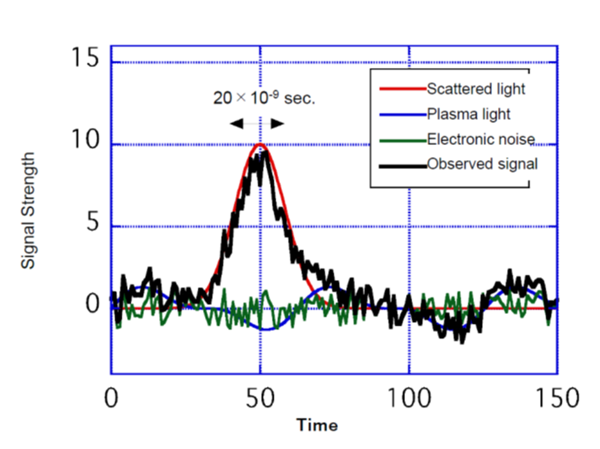HOME > Research Activities > Research Updates >
Enhancing Thomson Scattering Diagnostics
The high temperature plasma generating devices around the world, including the Large Helical Device (LHD), utilize Thomson scattering diagnostics for measuring an electron temperature and electron density. The measurement principle is to inject a powerful laser pulse (photons) into the plasma, to measure the scattered light upon having struck electrons moving in the plasma, and then to measure both electron temperature and electron density. The measurement principle is comparatively simple, but because the probability of light being scattered by an electron is extremely small it is necessary to pay close attention in conducting measurements. The Thomson scattering diagnostic laser device injects 1019 photons in one laser pulse. However, because an electron is extremely small at a diameter of 6×10-15m, a photon does not readily collide with an electron. The percentage of collisions is approximately 10-11, and the photon number of the scattered light is approximately 100 million (108) out of 1019. Moreover, because observation must be performed through a narrow observation window, the photon number which may actually be observed through diagnostics devices falls to 10,000 or less. Considered as probability, this is rather a thankless business. However, this light is extremely valuable as information for plasma temperature and density. In the LHD, utilizing the high performing Thomson scattering device, which utilizes the newest techniques, we have observed this light. This time, we have further upgraded this device.
Until now, we measured the light emitted from the plasma during injecting a single laser and that signal was considered to be due to the scattered laser light. However, the light emitted from plasma is not limited only to laser light scattered. There are various electrical noises. For this reason, in the signals obtained in earlier diagnostics there also was signal from other sources. We wish to distinguish between these noises and the scattered laser light that we want to measure. But there remained vagueness in the distinction of signals.
Thus, in order to be able to distinguish and to measure scattered light we examined upgrading the LHD’s Thomson scattering device. The purpose of upgrading is for high time-resolution. Temporal changes differ between scattered laser light and unwanted electrical noise signals. For that reason, if we can carefully measure temporal changes, for example, we can distinguish scattered light from electronic noise that shows fast temporal changes compared to scattered light. Further, the temporal change of signals when a laser pulse is not injected is primarily thought to be due to other light emitted from the plasma. By using this information we can precisely separate only the signal of the scattered light. The laser pulse signal for LHD Thomson scattering is extremely short at two seconds per 100 million (20 nanoseconds) timeframes. If we can measure the temporal resolution more finely at below one second per 2 billion (0.5 nanoseconds), then we can separate and measure the scattered light from others. Some twenty years ago, when the LHD Thomson scattering diagnostic was developed, diagnostics that could perform such measurements were extremely rare. Today, these diagnostics can now be used in various experimental fields due to technological innovations.
First, producing experimentally data collecting system that utilizes diagnostics with high temporal resolution, we tested this system in high-temperature plasma experiments, such as KSTAR in South Korea and HL-2A in the People’s Republic of China, in international collaborative research. As a result, compared with diagnostics used to date, the reliability of scattering data has been confirmed to have improved from by three to ten times. In the LHD, as well, from the nineteenth plasma experimental cycle which began in February 2017, we have been able to obtain still more highly reliable data of scattering data. From this data, we anticipate still further deepening of our understanding of high-temperature plasma through more accurate measurements of electron temperature and electron density.

Image 1: A schematic image of the signal from the Thomson scattering diagnostic. In the observed signal (black lines), in addition to the scattering of the laser pulse (red lines) other light from the plasma (blue lines) and electronic noise (green lines) are included. Because these time changes differ, if they can be measured at a high time resolution, we can separate the scattered light (red lines) that we truly wish to observe.

Image 2: A measurement result from the improved Thomson scattering diagnostic in LHD. The color of the line (channel) responds to the wavelength being observed. From the signal strength’s (vertical axis) dependence upon the wavelength the electron temperature can be known, and from the signal strength the electron density. There is almost no influence from noise in the channel with a strong intensity. When the signal is small, there is influence from noise, but eliminating this noise and estimating the scattered light is sufficiently effective.
